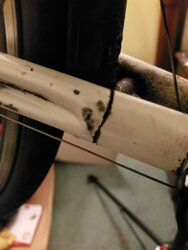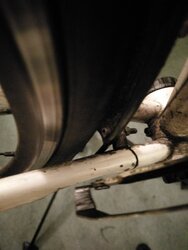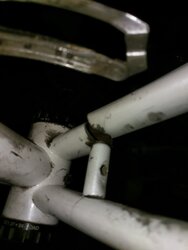You are using an out of date browser. It may not display this or other websites correctly.
You should upgrade or use an alternative browser.
You should upgrade or use an alternative browser.
An interesting break
- Thread starter GilesM
- Start date
Page may contain affiliate links. Please see terms for details.
ColinJ
Puzzle game procrastinator!
- Location
- Todmorden - Yorks/Lancs border
Doesn't surprise me - I have witnessed the brutal power of those long legs of yours!Riding home from work today, snapped right hand chainstay.

Shame about the bike ... I hope you weren't hurt?
Doesn't surprise me - I have witnessed the brutal power of those long legs of yours!
Shame about the bike ... I hope you weren't hurt?
Nah am fine, was on a flat road, handling started going a bit loose and the chain started skipping. Knew what it was more or less immediately, pulled over and checked and it was loose. It has snapped right at the bridge as you can see in the photos but I'm fairly certain it could be welded, might look a bit of a mess until I can get the frame resprayed and it would likely need aligning. @Yellow Saddle might have an opinion on this.
The good news is Mrs C is amenable to us doing it when I have a bit of spare cash, in her words "I really like that bike, you should fix it". On to a winner there.
Attachments
D
Deleted member 1258
Guest
Nah am fine, was on a flat road, handling started going a bit loose and the chain started skipping. Knew what it was more or less immediately, pulled over and checked and it was loose. It has snapped right at the bridge as you can see in the photos but I'm fairly certain it could be welded, might look a bit of a mess until I can get the frame resprayed and it would likely need aligning. @Yellow Saddle might have an opinion on this.
The good news is Mrs C is amenable to us doing it when I have a bit of spare cash, in her words "I really like that bike, you should fix it". On to a winner there.
I recon thats an excuse for santa to bring you a nice new shiny Xmas present.
I have just had a look at frames at Ribble. Fancy the 525 steel audax frame if I'm honest. But that'll be a new year thing, as will frame repairs.I recon thats an excuse for santa to bring you a nice new shiny Xmas present.
Wobblers
Euthermic
- Location
- Minkowski Space
First of all, Giles, very glad that neither 'contact' occurred, and thank you for sharing the failure and images.
I'd like to explore this.
First: the calculation derived from the assumption: 1000 miles a year for 10 years = 10 million turns of the crank. I don't know if work has been done on average development (ie how far a bike travels for each crank revolution) - for road and MTB - but let's say, for a MTB it's 4m (ie circumference (2.2m) x average gear ratio (1.8 - 40chainwheel/22t sprocket)). Taking McW's 1000 miles a year for 10 years, = 16,000km. So that's 4 million turns of the crank over 10 years (not McW's 10 million).
Second: McW: "any handlebars or stems [should be considered suspect] that . . . have seen similar use! I'd replace those as well if they're that age"
McW: "the fatigue life for aluminium is assumed to be 10 million cycles, though actual life will depend on what sort of loads it actually sees"
Fine. This reflects the fact that Aluminium does not have a distinct fatique limit and will eventually fail even from small stress amplitudes: 10 million is conventionally 'chosen' to represent the fatigue life of the material.
A road bike, if enthusiastically ridden through the year (like mine is), might do 10,000km (I have 559km to go: should just make it). On a road bike the average gear development is more likely in the region of 6m (ie circumference (2.2m) x average gear ratio (2.7 - 50chainwheel/18t sprocket)) so ~1.8 million turns of the crank for 10,000km. Should I be considering prophylactically replacing my bar (think the stem is far more robust/deliberately over-engineered) after its sixth year, as @McWobble recommends? Is creaking a sign of fatique life end approaching (I don't think so) (but no amount of copper slip 'tween stem and bar or retightening seems to reduce this when the bar is under load (ie climbing))?
Noting that the frame and forks are steel (thanks @User ).
Hah! I'm not writing a thesis (well, not another one, anyway!) It was a quick back of the head style calculation - and I didn't take account of wheel circumference, so that's why my 10 million cycles is too high.
But fatigue is a stochastic process - that is, it's random. One part may last for a million cycles while an apparently identical one may last 10 million. It's quite conceivable GilesM's other crank could soldier on for another ten years. Engineers are a conservative breed which is why they'll generally assume a 10 million cycle lifetime for a (relatively) lightly loaded aluminium part - there's a good chance that something else will do for that part before it fatigues, such as corrosion or wear. It's a rough rule of thumb rather than an absolute law.
Creaking in an aluminium part is a bad sign: it could well mean that there is a crack, and fretting is occuring across it as the load is applied/released. It may mean nothing, of course, but should be investigated. Fatigue life is heavily - exponentially, in fact - dependent upon the cyclic load. In aluminium, a cyclic load that reaches 70% of the metals ultimate tensile strenth (UTS) will likely fail after 10,000 cycles or so, but will last 10 million cycles at 30% UTS. So how long a part will last depends on its strength (which depends in turn on what alloy it's made from, size and thickenss) and the magnitude of the forces it experiences during service. The good news, @User, is that steel has a fatigue limit of about 40% UTS - so that at modest load, it won't fatigue - considering that you're a
I suspect that handlebars are fairly lightly loaded but the stress will be greater at the clamp and also at the brake lever clamp - both will act as stress raisers. These areas are the most likely places for cracks to start. One complication is that salt from sweaty hands is good at corroding aluminium. Corrosion pits are very good at creating local stress concentrations and starting the fatigue cracking process even where, overall, stress is low. In fact, it wouldn't surprise me if @GilesM's cracked crank started as a result of corrosion (and let's face it, a Scottish winter's quite enough to make anyone crack...[1]). Handlebars are cheap, dental work is not: if yours are creaking I probably would change them. Though check that it's not something else - are the brake lever clamps tight enough, for instance? It's definitely a ood idea to take of the bar tape and give bars, stem and fork a thorough check.
Whch reminds me: my Glasgow pub bike has cranks that are, ahem 25 years old. I really ought to give them a look over, shouldn't I?
[1] Sorry, I've already got my coat...
Yellow Saddle
Guru
- Location
- Loch side.
Hah! I'm not writing a thesis (well, not another one, anyway!) It was a quick back of the head style calculation - and I didn't take account of wheel circumference, so that's why my 10 million cycles is too high.
But fatigue is a stochastic process - that is, it's random. One part may last for a million cycles while an apparently identical one may last 10 million. It's quite conceivable GilesM's other crank could soldier on for another ten years. Engineers are a conservative breed which is why they'll generally assume a 10 million cycle lifetime for a (relatively) lightly loaded aluminium part - there's a good chance that something else will do for that part before it fatigues, such as corrosion or wear. It's a rough rule of thumb rather than an absolute law.
Creaking in an aluminium part is a bad sign: it could well mean that there is a crack, and fretting is occuring across it as the load is applied/released. It may mean nothing, of course, but should be investigated. Fatigue life is heavily - exponentially, in fact - dependent upon the cyclic load. In aluminium, a cyclic load that reaches 70% of the metals ultimate tensile strenth (UTS) will likely fail after 10,000 cycles or so, but will last 10 million cycles at 30% UTS. So how long a part will last depends on its strength (which depends in turn on what alloy it's made from, size and thickenss) and the magnitude of the forces it experiences during service. The good news, @User, is that steel has a fatigue limit of about 40% UTS - so that at modest load, it won't fatigue - considering that you're askinny waifpixie, you probably don't have to worry about your steel handlebars fatiguing. Rust, on the other hand...
I suspect that handlebars are fairly lightly loaded but the stress will be greater at the clamp and also at the brake lever clamp - both will act as stress raisers. These areas are the most likely places for cracks to start. One complication is that salt from sweaty hands is good at corroding aluminium. Corrosion pits are very good at creating local stress concentrations and starting the fatigue cracking process even where, overall, stress is low. In fact, it wouldn't surprise me if @GilesM's cracked crank started as a result of corrosion (and let's face it, a Scottish winter's quite enough to make anyone crack...[1]). Handlebars are cheap, dental work is not: if yours are creaking I probably would change them. Though check that it's not something else - are the brake lever clamps tight enough, for instance? It's definitely a ood idea to take of the bar tape and give bars, stem and fork a thorough check.
Whch reminds me: my Glasgow pub bike has cranks that are, ahem 25 years old. I really ought to give them a look over, shouldn't I?
[1] Sorry, I've already got my coat...
If you examine that crank, I guarantee you that you will find that the crack started at a stress riser caused by the pedal shoulder fretting into the crank.
Yellow Saddle
Guru
- Location
- Loch side.
The crack is slap bang in the heat-affected zone where the bridge was brazed onto the chainstay. It means that the weld/braze went slightly over the allowable temperature of that particular steel at the time, causing early fatigue. Re-welding/brazing it will not work for long.Nah am fine, was on a flat road, handling started going a bit loose and the chain started skipping. Knew what it was more or less immediately, pulled over and checked and it was loose. It has snapped right at the bridge as you can see in the photos but I'm fairly certain it could be welded, might look a bit of a mess until I can get the frame resprayed and it would likely need aligning. @Yellow Saddle might have an opinion on this.
The good news is Mrs C is amenable to us doing it when I have a bit of spare cash, in her words "I really like that bike, you should fix it". On to a winner there.
This happened to me yesterday and I wasn't so lucky.
https://www.cyclechat.net/threads/tales-from-todays-commute.105055/post-4603114
Report is here.
HLaB
Marie Attoinette Fan
I was very lucky when my old Kinesis Scandium failed just like Si_c's, I noticed it the day before the 45mph descent of the Cairngorm Mountain 

fossyant
Ride It Like You Stole It!
- Location
- South Manchester
That's another that looks like it's been cracked a while - colour difference in the crank.



